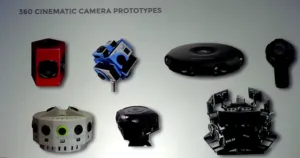At TSC, Jaunt VR CTO Arthur van Hoff gave a keynote address and participated in two panel discussions. In his keynote, he started by providing a nice overview of current VR headsets noting that the explosion of smartphones and the technology inside is the reason that VR applications are now poised to take off. AR applications will lag VR he thinks, as these solutions present much more difficult problems to solve in displays, tracking accuracy and registration, applications and the user interface.
In VR, one class of headsets, such as Google cardboard and Samsung GearVR, is more mobile and uses smartphones to power them. A second class offers a more powerful solution but requires tethering to a beefy PC. Examples here include the Oculus Rift, Sony Morpheus and Microsoft Hololens. The mobile devices are available today but the higher performance class devices are still in development.
Jaunt, along with several other competitors, makes a 360-degree capture camera. He sees these products in a different category from the rash of consumer-oriented 360-degree or 180-degree capture devices. These consumer devices are small, lightweight and try to cram the cameras close together for low cost. But this close packing also makes it difficult to create good stereo images and their small form factor means they are likely to be used by consumers in very mobile acquisition applications. Such mobility is not a good thing in immersive VR playback as it causes nausea quite quickly. For these reasons, he sees user-generated content not being very compelling as a driving force in the near term.
Professionally generated content seeks to overcome these shortcomings with better rigs, improved stereo pair generation and better stitching algorithms. He calls these 360 cinematic cameras (see photo – the Jaunt device is in the lower left).
Jaunt’s capture platform has been used in a number of ways so far ranging from concerts, to red carpet events and including music videos, travel promotion, news gathering, education, advertisements, sporting events and more.
Jaunt has learned a lot in developing the techniques for 360 cinematic capture, but there are a number of production challenges. He listed:
- Story telling and ways to focus attention in 360 VR – pointing is one good way as there is no director to give you the viewpoint
- Set construction and lighting – it is now a 360 degree set. Where do you place the cameraman?
- Camera motion – stable and stationary or slow dolly rolls is best
- Sound production – you need 3D immersive sound. They actually try to localize a sound so it is stationary in space even if you turn your head. Jaunt also now has a deal with Dolby to bring Atmos sound to its VR experiences
- Special effects – tools needs to be developed to support 360 degree formats
- Post production – tools need development and standardization of formats is an issues as well. How do you define the frame rate, resolution, field of view, stereo or mono, camera sync, stitching algorithms, 3D sound, etc.? Should all of this be carried as metadata to aid in headset rendering?
Jaunt is now offering VR content as a cloud-based service but it is a fundamentally different experience that will require a lot of experimentation to develop ways to use this new story telling medium. Right now, the company is concentrating on getting content out into the market. There is no real business model to support this other than promotional support from advertisers or promotion groups. Longer term, van Hoff thinks the company may be able to monetize its efforts by charging to distribute live streams like VR concerts, sporting events and more. – Chris Chinnock
This is a bold new frontier and it will be exciting to watch it evolve. (CC)

